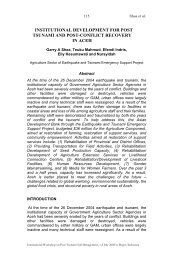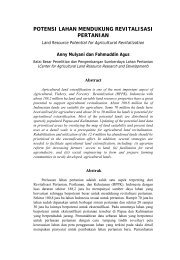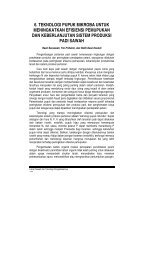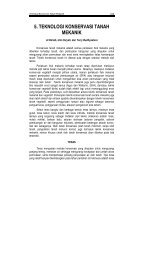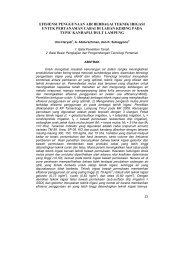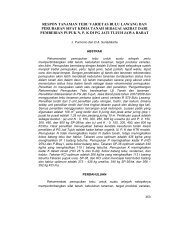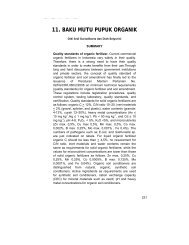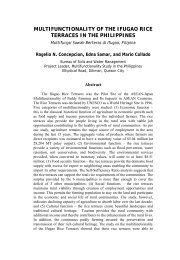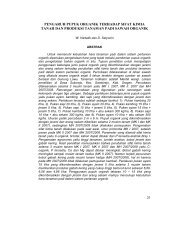Proceedings - Balai Penelitian Tanah
Proceedings - Balai Penelitian Tanah
Proceedings - Balai Penelitian Tanah
You also want an ePaper? Increase the reach of your titles
YUMPU automatically turns print PDFs into web optimized ePapers that Google loves.
POVERTY AND TREE CROPS<br />
91<br />
Joshi L<br />
Poverty is predominantly a rural phenomenon (Table 1). A closer look<br />
at the poverty incidence in Aceh indicates a disparity between people<br />
living along the coastal areas and those living further upland. The<br />
upland or inland people suffered more from political isolation, conflict<br />
and fear; they are poor and disadvantaged.<br />
Table 1. Poverty incidence in Aceh and Indonesia, 2004 to 2006<br />
Year 2004 2005 2006<br />
Aceh Province 28.4 32.6 26.5<br />
Urban 17.6 20.4 14.7<br />
Rural 32.6 36.2 30.1<br />
Indonesia<br />
Source (World Bank 2008)<br />
16.7 16.0 17.8<br />
A study was conducted in June-August 2007 along coastal and upland<br />
areas in three locations - accessible East Aceh with strong conflict<br />
history, less accessible West Aceh with some conflict history, and the<br />
remote island of Nias with no conflict history. Primary data and<br />
secondary information were collected through household interviews,<br />
group appraisals and expert consultations from sample villages, both<br />
in coastal as well as inland areas. Data on deforestation were<br />
analyzed and comparisons were made between coastal and upland<br />
regions regarding livelihood strategies, land use household income,<br />
environmental damage after December 2004.<br />
About 54% of the district populations live inland and nearly 94% of<br />
these inland people rely on agriculture compared to 55% in the<br />
coastal areas. The proportion of households below the poverty line in<br />
all study sites is far higher than the national average (Table 1). In rural<br />
communities in the uplands of Aceh and Nias, agriculture is the basis<br />
of daily lives. In the inland average of 76% total income comes from<br />
agricultural activities and 21% from off-farm activities. Within<br />
agriculture tree crops form the predominant source providing up to<br />
78% of household income. Compared to coastal communities the<br />
upland people depend more on tree crops and other forest resources<br />
as there are fewer off-farm economic opportunities (Table 2). People<br />
living in the inland areas are far poorer than those living along the<br />
coastal regions.<br />
International Workshop on Post Tsunami Soil Management, 1-2 July 2008 in Bogor, Indonesia



